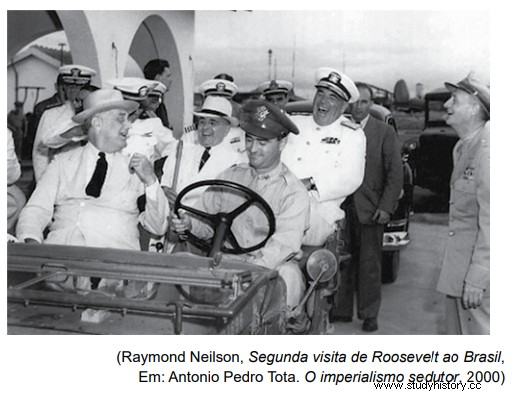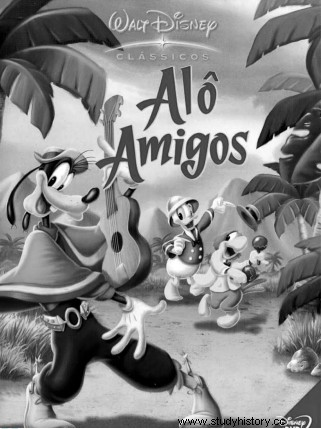Question 02 - UECE 2010 - The Good Neighbor Policy, led by the USA between 1933 and 1945, sought to develop strategies aimed at strengthening commercial, political and cultural relations with Latin America. Using the mass media (cinema, magazines and newspapers), he sought to popularize the idea of union between the Americas. On the topic, tick the correct one. a) Characters like Donald Duck, Zé Carioca and Panchito, created by Walt Disney, subliminally represented their countries of origin with their own characteristics. b) The American cultural industry, especially Hollywood, between 1933 and 1945, refused to make possible approximations with other Latin American countries. c) The good neighbor policy was conducted through political negotiations between the leaders of the countries of the American continent, without cultural concerns. d) The mass media were used by the Americans in their quest for leadership in the three Americas only after the Second World War.
Question 03 - FGV-SP - The image depicts an episode from 1943, in the city of Natal:the presence of the president of Brazil, Getúlio Vargas, and the president of the United States, Franklin Roosevelt.
 This episode is part of a broader context, represented by the Good Neighbor Policy, which was constituted in a) strong mobilization of the governments of the United States and Brazil in the sense of an unprecedented economic collaboration, materialized in the American offer of technology for the recent Brazilian automobile industry and the shipment of steel to the industries of the United States. b) joint action by the government and large North American businessmen to obtain large profits in Brazil and in Latin America through direct investments in urban equipment, especially public transport and the production and distribution of energy. c) new diplomatic and commercial posture of the United States towards Latin America, especially towards Argentina, Brazil and Mexico, which articulated a political-economic bloc with the aim of establishing more effective relations with England and France. d) radical reorganization of Brazilian foreign policy, which became guided by economic pragmatism, in which the Vargas government sought the best conditions to guarantee the development of basic industry, alternating approximations between the United States and England. e) US diplomatic practice for Latin America, which abandoned interventionism, opting for diplomatic negotiation and economic and military assistance, such as the loan for the construction of a steel mill in Brazil, in order to limit European influence in the region.
This episode is part of a broader context, represented by the Good Neighbor Policy, which was constituted in a) strong mobilization of the governments of the United States and Brazil in the sense of an unprecedented economic collaboration, materialized in the American offer of technology for the recent Brazilian automobile industry and the shipment of steel to the industries of the United States. b) joint action by the government and large North American businessmen to obtain large profits in Brazil and in Latin America through direct investments in urban equipment, especially public transport and the production and distribution of energy. c) new diplomatic and commercial posture of the United States towards Latin America, especially towards Argentina, Brazil and Mexico, which articulated a political-economic bloc with the aim of establishing more effective relations with England and France. d) radical reorganization of Brazilian foreign policy, which became guided by economic pragmatism, in which the Vargas government sought the best conditions to guarantee the development of basic industry, alternating approximations between the United States and England. e) US diplomatic practice for Latin America, which abandoned interventionism, opting for diplomatic negotiation and economic and military assistance, such as the loan for the construction of a steel mill in Brazil, in order to limit European influence in the region.Question 04 - PUC-Campinas 2017 - There is no doubt that the Week was conceived by its creators to cause a frenzy, set a date, generate friction and establish itself as a symbolic mark of a transformation. Without reactions of displeasure, without controversy and without boos, the plan was in danger of foundering. The press, by the way, had already touched the wound, in the coverage of the first night, when noticing that the hostile expectation of the public had turned into applause – the opposite of what was expected of a futuristic event (...). (GONÇALVES, Marco Augusto. 1922. The week that didn't end. São Paulo:Companhia das Letras, 2012. p. 299) In Latin America, the mainstream press, as well as other mass media, participated in campaigns and programs that sought to enhance the image of the United States on the continent. This was evident during the a) Good Neighbor Policy, launched with the objective of favoring the US recovery from the effects of the 1929 crisis through international agreements to obtain raw materials, and through various cooperation actions. b) Operation Condor, an articulation of opposition movements to Latin American military regimes that had the support of the United States in order to condemn authoritarian governments and defend democracy. c) Alliance for Progress, shortly after World War II, when the US government installed branches of the Office of the Coordinator Inter-American Affairs, an agency in charge of promoting economic and cultural cooperation programs, in several Latin American countries. d) Operation Brother Sam, action by the US Armed Forces on the Brazilian coast to guarantee the inauguration of João Goulart, when President Jânio Quadros resigned. e) Operation Pan-American (OPA), implemented by President John Kennedy to stop the advance of the “red peril” and the armed struggle in Latin America, after the revolution in Cuba opted for the socialist regime in 1959.
Question 05 - Mackenzie 2016/1 -

“So Nelson Rockefeller convinced Walt Disney (...) to film in Latin America, from which the drawings Alô, Amigos (1943) and Você já vai à Bahia? (1945) and the character of the parrot Zé Carioca. And it was also Rockefeller who literally summoned Orson Welles (…) to drop what he was doing (…) and go to Rio to shoot a film about Carnival, called It’s all true”. Ruy Castro. Carmen Miranda:A biography. São Paulo:Companhia das Letras, 2005, p.333 The text and image demonstrate the adherence of RKO – a film studio belonging to the Rockefeller family that distributed Disney and Welles films – to the Good Neighbor Policy. Regarding this Policy, the following statements are made:I. It emerged in the 1930s, it consisted of a new relationship strategy between the United States and Latin America, abandoning the interventionist practice prevailing since the end of the 19th century. II. Diplomatic negotiation and economic and military collaboration with Latin American countries became his landmarks for actions, hindering the economic presence of Nazi Germany in the region. III. The adhesion of Hollywood studios to Good Neighbor would make it possible to compensate for the loss of the US film market in countries dominated by the Axis. Tick a) if only statement I is correct. b) if only statements I and II are correct. c) if all the statements are correct. d) if only statements II and III are correct. e) if only statements I and III are correct.
CHECK 01 - C02 - A03 - E04 - A05 - C
